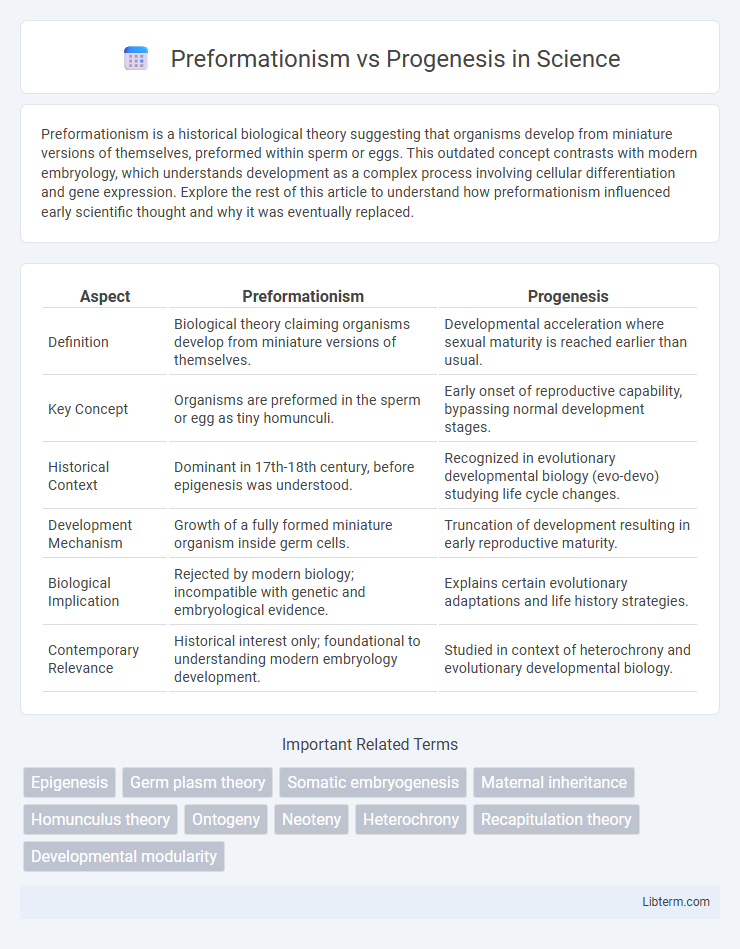Preformationism is a historical biological theory suggesting that organisms develop from miniature versions of themselves, preformed within sperm or eggs. This outdated concept contrasts with modern embryology, which understands development as a complex process involving cellular differentiation and gene expression. Explore the rest of this article to understand how preformationism influenced early scientific thought and why it was eventually replaced.
Table of Comparison
| Aspect | Preformationism | Progenesis |
|---|---|---|
| Definition | Biological theory claiming organisms develop from miniature versions of themselves. | Developmental acceleration where sexual maturity is reached earlier than usual. |
| Key Concept | Organisms are preformed in the sperm or egg as tiny homunculi. | Early onset of reproductive capability, bypassing normal development stages. |
| Historical Context | Dominant in 17th-18th century, before epigenesis was understood. | Recognized in evolutionary developmental biology (evo-devo) studying life cycle changes. |
| Development Mechanism | Growth of a fully formed miniature organism inside germ cells. | Truncation of development resulting in early reproductive maturity. |
| Biological Implication | Rejected by modern biology; incompatible with genetic and embryological evidence. | Explains certain evolutionary adaptations and life history strategies. |
| Contemporary Relevance | Historical interest only; foundational to understanding modern embryology development. | Studied in context of heterochrony and evolutionary developmental biology. |
Introduction to Preformationism and Progenesis
Preformationism is a historical biological theory asserting that organisms develop from miniature versions of themselves, known as homunculi, fully formed within the reproductive cells. In contrast, progenesis describes an evolutionary process where an organism attains sexual maturity earlier, resulting in a shortened development period and often smaller adult size. Understanding these concepts is critical to exploring early developmental biology and evolutionary adaptations.
Historical Background of Preformationism
Preformationism emerged in the 17th century as a biological theory proposing that embryos develop from miniature, fully-formed organisms called homunculi, present in sperm or eggs. This idea was influenced by early microscopy advancements and philosophical beliefs in preexistence and determinism, notably supported by scientists like Jan Swammerdam and Nicolas Malebranche. Preformationism dominated embryological thought until the 18th century when it was challenged by epigenesis, emphasizing gradual development from undifferentiated material.
Origins and Development of Progenesis
Progenesis, an alternative developmental strategy to preformationism, originates from evolutionary adaptations where organisms reach reproductive maturity faster by accelerating gonadal development relative to somatic growth. This heterochronic shift enables earlier reproductive capability, often observed in species inhabiting unstable or resource-limited environments. Developmentally, progenesis involves hormonal and genetic regulation that truncates the growth phase, favoring early gamete production over full morphological maturation.
Key Differences Between Preformationism and Progenesis
Preformationism asserts that organisms develop from miniature, fully formed versions of themselves called homunculi, implying that all traits are inherited from a pre-existing structure within the egg or sperm. In contrast, progenesis involves accelerated sexual maturation occurring earlier in an organism's life cycle, leading to reproductive capability before full somatic development. The key difference lies in preformationism's emphasis on predetermined, complete structures at conception versus progenesis's focus on developmental timing and early reproduction.
Major Proponents and Influential Theories
Preformationism, championed by scientists like Marcello Malpighi and Nicolas Hartsoeker in the 17th century, posited that organisms develop from miniature versions of themselves, encapsulated in the sperm or egg, emphasizing pre-existing structures. Progenesis, advocated by Ernst Haeckel in the 19th century, proposed that early sexual maturity results from accelerated development, influencing evolutionary developmental biology and heterochrony theories. Both perspectives profoundly shaped embryology and evolutionary thought, with preformationism eventually supplanted by epigenesis and progenesis providing insights into life cycle variations and evolutionary strategies.
Scientific Evidence Supporting Each Concept
Scientific evidence for preformationism includes early microscopy observations suggesting miniature forms within sperm or eggs, but advanced imaging and genetic studies refute this by demonstrating gradual embryonic development from undifferentiated cells. Progenesis finds support in evolutionary developmental biology, showing accelerated maturation in some species supported by gene expression patterns that trigger early reproductive capability. Modern embryology and molecular biology largely favor progenesis, as genetic regulation and cellular differentiation provide robust explanations for developmental timing, contradicting preformationism's notion of pre-existing complete organisms.
Preformationism vs Progenesis in Embryology
Preformationism posits that organisms develop from miniature versions of themselves already present in the germ cells, whereas progenesis in embryology refers to the acceleration of sexual maturity before the completion of typical somatic development. Preformationism emphasizes predetermined structures encoded in germ cells, contrasting with progenesis, which alters the timing of developmental stages to hasten reproduction. Understanding these concepts aids in interpreting developmental mechanisms, with preformationism historically influencing early embryological theories and progenesis revealing evolutionary adaptations in developmental timing.
Impacts on Evolutionary Biology
Preformationism, the belief that organisms develop from miniature versions of themselves, limited early understanding of genetic variation and adaptive evolution by implying predetermined traits. Progenesis, which involves the acceleration of reproductive maturity, highlighted the role of developmental timing in evolutionary change, influencing concepts of heterochrony and life history strategies. These contrasting perspectives shaped modern evolutionary biology by emphasizing the importance of developmental processes and genetic regulation in shaping phenotypic diversity.
Modern Perspectives and Debates
Modern perspectives on preformationism and progenesis emphasize their historical significance while highlighting advances in developmental biology that disprove rigid preformationist models. Current debates center on gene regulation and epigenetic factors that govern growth and differentiation, challenging simplistic views of hereditary preformation or early developmental maturation. Integrating molecular genetics with evolutionary developmental biology offers nuanced insights into progenesis mechanisms without reverting to outdated preformationist doctrines.
Conclusion and Future Directions
Preformationism, which posits that organisms develop from miniature versions of themselves, contrasts with progenesis, where maturation accelerates to produce adults at juvenile stages. Current research reveals that progenesis involves complex gene regulation and epigenetic factors influencing developmental timing, suggesting evolutionary adaptability. Future studies should explore molecular mechanisms driving these processes and their implications for evolutionary developmental biology and medical science.
Preformationism Infographic

 libterm.com
libterm.com